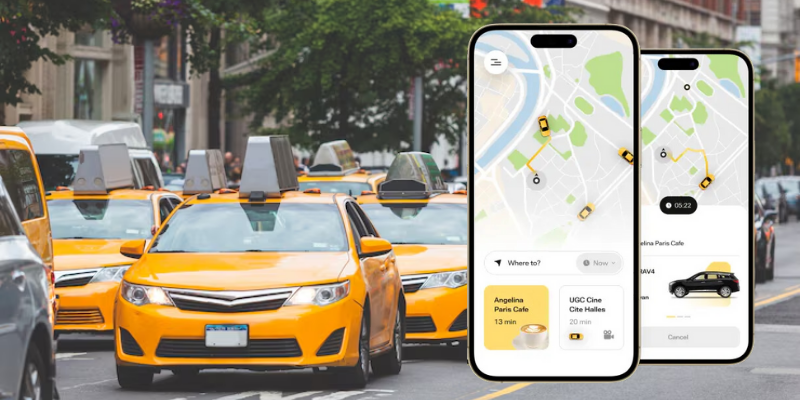The taxi app market has seen rapid growth over the last decade, driven by rising demand for on-demand transportation services. With the popularity of companies like Uber and Lyft, entrepreneurs and businesses are keen to build their own taxi apps to capitalize on this lucrative market. However, developing a successful taxi app is a difficult process that involves meticulous strategy, development, and execution. This comprehensive guide will walk you through the whole taxi app development process, from early planning to launch and growing.
1. Understanding the Taxi App Market
Before diving into the development process, it’s crucial to understand the current state of the taxi app market. The global taxi app market is expected to continue its growth, driven by urbanization, the rise of digital payment systems, and the convenience of on-demand services. Key players like Uber, Lyft, Grab, and DiDi dominate the market, but there’s still room for new entrants, especially in niche markets or regions where these giants have limited presence.
Key Market Insights:
-
Market Size and Growth: The global ride-hailing market was valued at over $85 billion in 2023 and is expected to grow at a CAGR of 15% from 2024 to 2028.
-
User Demographics: The majority of users are millennials and Gen Z, who prefer using apps for transportation due to the convenience, ease of use, and cashless payments.
-
Competitive Landscape: While the market is competitive, there are opportunities for differentiation through unique features, superior customer service, and local market adaptation.
2. Key Features of a Taxi App
To build a competitive taxi app, it’s essential to include features that meet user expectations and enhance their experience. These features can be broadly categorized into three categories: passenger app features, driver app features, and admin panel features.
Passenger App Features
-
User Registration and Profile: Simple sign-up options using email, phone number, or social media accounts.
-
Ride Booking: Easy ride booking with options for ride type (e.g., economy, premium, carpool).
-
Real-time GPS Tracking: Track the driver’s location and estimated time of arrival (ETA).
-
Payment Integration: Multiple payment options, including credit/debit cards, e-wallets, and cash.
-
Ride History: Access to previous rides, receipts, and ability to rebook.
-
In-app Messaging: Communication with the driver without sharing personal contact details.
-
Push Notifications: Alerts for ride status, driver arrival, promotions, etc.
-
Ratings and Reviews: Rate drivers and provide feedback.
Driver App Features
-
Driver Registration and Verification: Profile creation and document submission for verification.
-
Ride Alerts: Notifications for ride requests and cancellations.
-
Navigation and Route Optimization: Integrated maps and GPS for efficient routing.
-
Earnings Dashboard: Track daily, weekly, and monthly earnings.
-
Availability Toggle: Switch between online (available) and offline (unavailable) modes.
-
In-app Communication: Messaging system to communicate with passengers.
Admin Panel Features
-
Dashboard: Overview of app activities, including ride requests, completed rides, and revenue.
-
User and Driver Management: Tools to manage user and driver profiles, including verification, bans, and more.
-
Analytics and Reporting: Detailed reports on user activity, revenue, driver performance, etc.
-
Fare Management: Setting and adjusting fare rates based on time, location, and demand.
-
Promotions and Discounts: Ability to create and manage promotional campaigns.
-
Customer Support: Tools for handling customer queries and issues.
3. Step-by-Step Guide to Taxi App Development
A. Market Research and Planning
The first step in developing a taxi app is conducting thorough market research and creating a detailed plan. This involves understanding your target audience, analyzing competitors, and identifying the unique selling points (USPs) of your app.
Key Steps:
-
Identify Target Audience: Understand who your potential users are, their needs, and preferences. Consider demographics, geographic location, and transportation habits.
-
Competitor Analysis: Study existing taxi apps to identify their strengths and weaknesses. Look for gaps in the market that your app can fill.
-
Define USPs: Determine what will make your app stand out. This could be lower fares, superior customer service, or innovative features.
-
Create a Business Model: Decide how your app will generate revenue. Common models include commission-based (charging drivers a percentage of each fare), subscription-based (charging drivers a monthly fee), and advertising.
B. Designing the User Experience (UX) and User Interface (UI)
A user-friendly design is critical to the success of your taxi app. The design should be intuitive, allowing users to book rides with minimal effort.
Key Steps:
-
Wireframing: Create wireframes for the app’s layout, showing the placement of buttons, menus, and other elements.
-
Prototyping: Develop a clickable prototype to visualize the user flow and interactions.
-
UI Design: Focus on aesthetics, including color schemes, typography, and branding elements. The design should be visually appealing and consistent with your brand.
-
User Testing: Conduct usability tests with a small group of users to gather feedback and make necessary adjustments.
C. Choosing the Right Technology Stack
The technology stack you choose will have a significant impact on the performance, scalability, and security of your taxi app. Your tech stack should be robust enough to handle high traffic and complex operations like real-time tracking and payment processing.
Key Considerations:
-
Frontend: Use modern frameworks like React Native, Flutter, or Swift for iOS and Kotlin for Android to ensure smooth and responsive user interfaces.
-
Backend: Choose a scalable backend platform like Node.js, Django, or Ruby on Rails. These platforms are known for their performance and ability to handle large amounts of data.
-
Database: Use databases like PostgreSQL or MongoDB for storing user data, ride history, and other critical information.
-
Cloud Services: Leverage cloud services like AWS, Google Cloud, or Azure for scalable server hosting, data storage, and analytics.
-
APIs: Integrate third-party APIs for maps (Google Maps, Mapbox), payments (Stripe, PayPal), and notifications (Firebase, Twilio).
D. Backend and Frontend Development
The development phase is where your taxi app starts to take shape. This involves both frontend (user-facing) and backend (server-side) development.
Key Steps:
-
Frontend Development: Focus on developing a responsive and interactive user interface. This includes integrating maps, forms, and real-time tracking features.
-
Backend Development: Build a secure and scalable backend that can handle user requests, process payments, manage ride data, and more.
-
API Integration: Connect your app with external services like payment gateways, map services, and SMS providers.
-
Real-time Features: Implement WebSocket or other real-time communication protocols to enable features like live tracking and instant notifications.
E. Integrating Essential Features
Once the basic structure of the app is in place, it’s time to integrate the essential features that will define your app’s functionality.
Key Features:
-
GPS and Navigation: Integrate a reliable GPS system for real-time tracking and route optimization.
-
Payment Gateway: Add support for multiple payment options, ensuring secure transactions.
-
Ride Matching Algorithm: Develop an algorithm to match riders with the nearest available drivers, taking into account factors like location, traffic, and driver preferences.
-
Push Notifications: Implement push notifications for ride updates, driver arrival, payment receipts, and promotions.
-
Security Features: Include features like two-factor authentication, secure data encryption, and driver/passenger verification to ensure user safety.
F. Testing and Quality Assurance
Testing is a critical phase that ensures your app is free of bugs and functions as intended. Both manual and automated testing methods should be employed.
Key Testing Types:
-
Unit Testing: Test individual components of the app for functionality.
-
Integration Testing: Ensure that different modules of the app work together seamlessly.
-
Usability Testing: Evaluate the app’s user interface and experience by observing real users as they interact with it.
-
Performance Testing: Test the app’s performance under various conditions, such as high traffic or poor network connectivity.
-
Security Testing: Identify and fix vulnerabilities to protect user data and prevent breaches.
G. Launching the App
Once the app has passed all tests and is ready for the public, it’s time to launch. This involves submitting the app to app stores, marketing it to potential users, and preparing for the initial influx of traffic.
Key Steps:
-
App Store Optimization (ASO): Optimize your app’s title, description, keywords, and screenshots to rank higher in app store searches.
-
Marketing and Promotion: Use social media, content marketing, and paid advertising to generate buzz and attract users.
-
Launch Events: Consider hosting a launch event or offering special promotions to encourage early adoption.
-
Monitoring and Support: After launch, monitor app performance closely and provide customer support to address any issues.
4. Post-Launch Activities
The work doesn’t end with the launch. Post-launch activities are crucial for maintaining user engagement and improving the app based on user feedback.
Key Activities:
-
User Feedback: Gather and analyze user feedback to identify areas for improvement.
-
Regular Updates: Continuously update the app with new features, performance enhancements, and security patches.
-
User Retention: Implement strategies like loyalty programs, discounts, and referral bonuses to retain users.
-
Scaling: As your user base grows, ensure your infrastructure can scale to handle increased traffic and data.
5. Cost Considerations
Developing a taxi app involves significant investment, and understanding the cost factors can help in budgeting and resource allocation.
Key Cost Factors:
-
Development Team: Hiring skilled developers, designers, and testers can be a major cost driver. You can choose between in-house development or outsourcing.
-
Technology Stack: Costs associated with the technology stack, including cloud services, APIs, and software licenses.
-
Design and UX/UI: Investing in a good design is essential, but it also comes with a cost.
-
Marketing and Promotion: Budget for pre-launch and post-launch marketing activities.
-
Maintenance and Updates: Ongoing costs for app maintenance, updates, and support.
6. Challenges and How to Overcome Them
Developing a taxi app is not without challenges. Understanding these challenges and how to overcome them is crucial for success.
Key Challenges:
-
High Competition: The taxi app market is saturated with big players. Differentiation through unique features and superior service is key.
-
Regulatory Hurdles: Navigating local laws and regulations regarding ride-hailing services can be complex. Ensure compliance to avoid legal issues.
-
User Trust: Building and maintaining user trust is critical. This can be achieved through secure payment systems, verified drivers, and responsive customer support.
Overcoming Challenges:
-
Market Differentiation: Focus on a specific niche or market to stand out.
-
Regulatory Compliance: Work with legal experts to ensure your app complies with all relevant regulations.
-
Enhanced Security: Implement robust security measures to protect user data and build trust.
7. Future Trends in Taxi App Development
The future of taxi app development is likely to be shaped by emerging technologies and changing consumer preferences. Staying ahead of these trends can give your app a competitive edge.
Key Trends:
-
Electric and Autonomous Vehicles: The integration of electric and self-driving vehicles is expected to revolutionize the ride-hailing industry.
-
AI and Machine Learning: AI-driven algorithms for ride matching, dynamic pricing, and personalized user experiences will become more prevalent.
-
Blockchain: Blockchain technology could enhance transparency and security in payment processing and data management.
-
Sustainability: There is a growing demand for eco-friendly transportation options, which could lead to the development of green taxi services.
Conclusion
Creating a taxi app is a difficult process that involves meticulous strategy, implementation, and ongoing refinement. By following the methods given in this guide, you can build a strong, user-friendly, and competitive taxi app that fits the demands of today’s customers. Whether you’re targeting a niche market or aiming to compete with the giants, success will be determined by your ability to innovate, adapt, and provide a superior customer experience.




